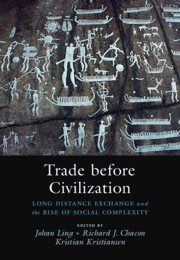Book contents
- Trade before Civilization
- Trade before Civilization
- Copyright page
- Contents
- Contributors
- Chapter One New Perspectives on Long-Distance Trade and Social Complexity
- Part I Exchange and Social Evolution: Forms of Trade in Egalitarian, Transegalitarian, and Chiefdom Societies
- Part II The Role That Specific Institutions And Agents Played in Long-Distance Exchange
- Chapter Six Middle Bronze Age Long-Distance Exchange
- Chapter Seven Culture Heroes, Inalienable Goods, and Religious Sodalities
- Chapter Eight Trade and Calusa Complexity
- Part III The Role of Political Economy and Elite Control in Long-Distance Exchange
- Part IV Marxian And Post-Colonial Approaches as well as World System Theory in Relation to Gift Exchange and MacroRegional Exchange
- Part V Commentary on Contributions to This Volume
- Index
- References
Chapter Seven - Culture Heroes, Inalienable Goods, and Religious Sodalities
Long-Distance Exchange in Eastern North America at European Contact
from Part II - The Role That Specific Institutions And Agents Played in Long-Distance Exchange
Published online by Cambridge University Press: 25 August 2022
- Trade before Civilization
- Trade before Civilization
- Copyright page
- Contents
- Contributors
- Chapter One New Perspectives on Long-Distance Trade and Social Complexity
- Part I Exchange and Social Evolution: Forms of Trade in Egalitarian, Transegalitarian, and Chiefdom Societies
- Part II The Role That Specific Institutions And Agents Played in Long-Distance Exchange
- Chapter Six Middle Bronze Age Long-Distance Exchange
- Chapter Seven Culture Heroes, Inalienable Goods, and Religious Sodalities
- Chapter Eight Trade and Calusa Complexity
- Part III The Role of Political Economy and Elite Control in Long-Distance Exchange
- Part IV Marxian And Post-Colonial Approaches as well as World System Theory in Relation to Gift Exchange and MacroRegional Exchange
- Part V Commentary on Contributions to This Volume
- Index
- References
Summary
Linking political economy and ritual economy perspectives focuses our attention to the articulation of aristocratic behavior and social hierarchies in chiefly and transegalitarian societies. The emergence, legitimation, and maintenance of aristocracy, heterarchy, and hierarchy is often linked to the widespread circulation, deployment, production, and use of alienable and inalienable goods (Brumfiel and Earle 1987; Earle 1997, 2002; Hayden 1998, 2001, 2011; Mills 2004; Agbe-Davies and Bauer 2010), but while such items may be restricted, they may also be appropriated by rivals and non-elite aggrandizers are threatened. Social institutions based on an emergent political and ritual economy typically involve complex interactions of labor intensification, ritual structures, surplus mobilization, and control over the distribution of highly valued and often exotic goods. Inalienable goods become increasingly restricted as elite aggrandizers institutionalize their authority and exert limitations over exchange nodes and spheres of influence (Earle 2002: 39).
- Type
- Chapter
- Information
- Trade before CivilizationLong Distance Exchange and the Rise of Social Complexity, pp. 142 - 172Publisher: Cambridge University PressPrint publication year: 2022
References
- 1
- Cited by



